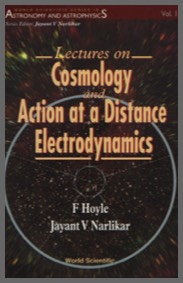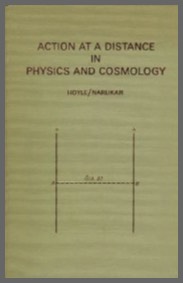Fred Hoyle An observer of the world and a ponderer on its problems ...
With Jayant Narlikar

Lectures on Cosmology and Action at a Distance - Electrodynamics 1996
The idea for this book came out of a review article we wrote in 1995 in Reviews of Modern Physics to highlight the recent developments in action at a distance electrodynamics. Our article was also meant to be a tribute to the paper by John A. Wheeler and Richard P. Feynman on "Interaction with the Absorber as a Mechanism for Radiation" which had appeared in the same journal fifty years earlier. In this paper Wheeler and Feynman had introduced their now famous absorber theory of radiation in order to present a consistent picture of classical electrodynamics within the framework of action at a distance, that is, without using the notion of a field with its own degrees of freedom. Continue
The absorber theory seemed to hold out hopes of linking the time asymmetry in electrodynamics to the large scale structure of the universe. Unfortunately Wheeler and Feynman did not explore this aspect further and the theory subsequently encountered problems at the quantum level. Later work by others, however, led to further progress on both these fronts with the result that most of the outstanding problems were resolved and by the early 1970s, the action at a distance description became at par with the standard field theoretic one.
Recent developments have taken the theory further and it is now seen that there is indeed a natural cut-off coming from cosmological boundary conditions which eliminates the so-called ultra-violet divergences in quantum electrodynamics. Thus the notorious infinities which require a renormalisation programme are eliminated. With this further input, we believe that the concept of action at a distance is now superior to the conventional field theory.
There is one important caveat, though. The cosmological boundary conditions that produce the right kind of time asymmetry at the classical level and provide the much needed cutoff at the quantum level are not satisfied by the currently popular big bang cosmology. They are satisfied by the steady state and the quasi-steady state cosmology, and in general by cosmologies that have a perfect future absorber and an imperfect past absorber. Moreover, the existence of an event horizon in the future also plays a critical role in making quantum electrodynamics convergent.
The failure of the conventional quantum field theory to deal with the problem of infinities is well known and has remained with us despite numerous attempts to resolve it. The success of the alternative approach described here reminds us that the problem is not purely local but that we need to include cosmological considerations.
We hope that the reader will see the merit of this approach and the important conclusions that it leads to. We urge him or her to weigh its advantages against the sacrifice of preconceived preferences for the big bang cosmology.
This monograph is aimed at students and research workers in theoretical physics and cosmology. We assume knowledge of electrodynamics, quantum mechanics and general relativity, although the description given here is self-contained. We have opted for the "Lecture" format to aim the book at classrooms.
We thank Professor K. K. Phua of World Scientific Publishing Company for inviting us to write this monograph.
Fred Hoyle Bournemouth, England
Jayant Narlikar Pune, India

The Physics-Astronomy Frontier 1980
The universe is necessarily wider in its range of phenomena than anything we can hope to experience here on Earth. Humans have ever looked to the heavens for clues to the nature and order of the world, and this is still true today. Physicists in search of the laws that order our world have turned to astronomy and cosmology for evidence to support their theories, and astronomers draw upon the experiments of physicists in earthly laboratories to understand the phenomena of the heavens. This fundamental interplay between physics and astronomy has inspired us to write The Physics-Astronomy Frontier. Continue
This book is concerned with astronomy from the point of view of the physicist, which is why we discuss such topics as the nature of atoms, quantum mechanics, and ideas about radiation right at the beginning. Unfortunately, human beings are not equipped with an instinctive understanding of these matters because everyday life is not much concerned with them. Indeed, one must go to a great deal of trouble and expense to become concerned with the structure of atoms, and the study of quantum mechanics was not widespread until the modern era of microelectronics. Yet, it is scarcely possible to proceed a step in our understanding of astronomy without coming to grips with these deeper parts of physics.
Order is maintained in the world through what is often referred to as "cause and effect." Cause and effect arise through interactions between particles, of which there are four kinds-electrical, strong, weak, and gravitational. These four interactions are discussed in the opening chapter, and each part of the book is devoted to the phenomena that fall within the scope of each kind of interaction. Part I, on the electrical interaction, describes astronomical knowledge gained from the radiation spectrum-optical, radio, millimeter-wave, infrared, and x-ray astronomy. Part II, on the strong and weak interactions, focuses on the properties of the interiors of stars. Part III, on the gravitational interaction, discusses the theories of Newton and Einstein as a basis for understanding black holes and the problems of cosmology. In each part, the fundamental physical discoveries are presented as the basis for understanding astronomical phenomena. We hope this method of organisation will provide a fresh view of astronomy not provided by most astronomy books, which focus on the order of discoveries or the objects encountered at increasing distances from Earth. By focusing on the fundamental forces at work in the universe, we provide a basis for understanding astronomical phenomena rather than simply describing them.
In this book we have limited ourselves to an almost entirely nonmathematical treatment. The most difficult mathematics is some simple algebra in Chapter 11. Without the algebra, we would have found it difficult to discuss the physics of black holes in a meaningful way. This book should easily be within the scope of anyone who has a strong high school background in general science.
We are very greatly indebted to Dr. John Faulkner for his careful and constructive evaluation of our manuscript and for the numerous suggestions he made for its improvement.
May 1980
Fred Hoyle Jayant Narlikar

Action at a Distance in Physics and Cosmology 1974
In the preface to this work, the authors explain the term "action at a distance" as being "......a relativistically invariant particle interaction, not the instantaneous action at a distance of Newton". In physics it is customary that interaction is used in some problems such as scattering, the general viewpoint being that interparticle action is merely part of a wider interaction of fields and particles. The authors challenge this conventional view by arguing that all the results of physics "....can be obtained from interparticle action - for decay problems and scattering problems alike". Continue
Hoyle and Narlikar go on to challenge another scientific conventionality which holds that the universe sets boundary conditions for the working of the laws of physics and that these laws act independently of large scale structure and could be discovered by local experimentation. Hoyle and Narlikar however argue in favour of a seamless garment for the laws of physics at local and universal levels.
Chapter 2, which deals with the theories of electromagnetism and gravitation, place theoretical physics within an historical perspective by explaining that such diverse phenomena as the swings of a pendulum, a falling apple and planetary motion all adhere to the same scientific laws.
In the following chapters, the authors go on to expound on Gauss's problem and how it was solved in the early 20th century by Schwarzschild, Tetrode and Fokker. As nature is quantum in character, classical particle physics is insufficient for the explanation of any physical theory, so the authors place electromagnetism within quantum theory. In chapter 5, Hoyle and Narlikar generalise the Fokker action to curved spacetime.
The book's authors succeed in obtaining a quantum generalisation of the electrodynamic case and how this leads "....to extension of the action at a distance point of view to all parts of physics." However, the authors admit that "...other major issues remain..... especially those related to short-range forces".